Stage 1: Evaluation (I) (Fact finding)
- Decide on what to find out and select appropriate sources of data and collect data as they become available
- Choose an assessment task to collect read-aloud performance of students
- Design a questionnaire for students to complete after the task
Evaluation |
Procedure |
Sept – Oct 2010
Design and implement diagnostic test
to assess current performance |
The teachers chose a read aloud assessment task to collect initial data on the delivery skills of P5 students. They administered a read-aloud test for individual students at the beginning of first term.
The passage ‘A book on Good Behaviour’ was written for the read-aloud test. The length of the text was similar to a TSA read-aloud passage. Context was related to the school life of the children and many words were chosen from the module units. This was to make sure that the text was not totally unfamiliar as that would be discouraging for the students.
The teachers video recorded the students' read-aloud performance. After the Read-aloud test, the students were asked to reflect on their preparation, strategies, strengths and weaknesses of their speaking performance they had faced by completing a questionnaire.
Some questions are:

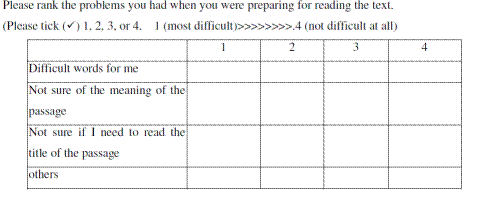
With the data of the test and the questionnaire, the teachers analysed different aspects of students’ pronunciation. They also tried to spot other weaknesses which had been neglected in the busy classroom. Through the collection of data about students’ performance, the teachers were able to make informed decisions about which areas to focus on specifically and how to go about addressing the needs of their students. |
Stage 2: Planning
- Analyze the data and spell out the findings and implications for practice
- Select a focus area for intensive teaching and learning
Oct 2010
Identify weaknesses and select focus areas for instruction
|
After the test, the teachers analysed the results and referred to the responses in the questionnaire when planning for remediation and instruction on difficult items. The test and the questionnaire provided useful information for the teachers. The students’ initial performance was not entirely satisfactory. Some students read softly and could hardly be heard. Besides, many could not read the sentences in meaningful units; instead they read word by word. Some students’ body language also showed a lack of confidence and hindered the rhythm of breathing during speaking. Paralinguistic features (i.e. gestures, facial expressions, volume, pauses, stress, intonation etc.) also required improvement because they can affect the meaning and delivery of the messages of a speaker.
The teachers also identified various kinds of mistakes in the pronunciation of the students. For example, some dropped the last sound of a word, mispronounced contracted words, and mixed up the blends and rimes of words.
Thus the teachers found it necessary to give remediation lessons to tackle some more urgent aspects, e.g. contracted forms/ negative short forms (e.g. shouldn't). But the more intensive work was placed on how to tackle unfamiliar words when reading a text. The decision was made because these are also common problems as pointed out in a TSA report in a seminar by HKEAA in 2010.
The teachers learned about the problems and strategies reported by the students in the post diagnostic test questionnaire. For example, some students knew ‘repair’ strategies, e.g. ‘transcribing the words literally to help with my pronunciation’, ‘to guess if I don’t know the words.’ Although the students had been previously told that they should rehearse silently before being asked to read a text aloud, this was of little value to them as they did not know any strategy to tackle the problems. Therefore, the teachers felt that they needed to teach basic phonics skills so that students could learn how to tackle unfamiliar words confidently. |
Stage 3: Planning-Implementation (I)
- Plan and implement scaffolding activities for student learning that take into account the findings and implications worked out
Oct 2010– Mar 2011
Remediation and instruction |
After selecting the focus areas for intensive teaching and learning, the teachers decided to provide remediation and instruction in the following aspects:
Sentence level : to improve body language and other paralinguistic features of speech.
a. Lessons on appropriate manners, voice and tempo when reading aloud.
- Teacher showed examples of good and bad manners when reading a text aloud
- Group activity :
- Students discuss the appropriate and inappropriate manners and postures based on the data collected (recording of initial students performance)
|
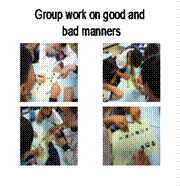
|
The students learned to pause and add stress to words in the text, etc. at the connected speech level. They also learned to use appropriate posture and gestures to make their voice audible when reading aloud. This helped with their fluency in speaking.
b. Lessons on using punctuation (e.g. comma, full-stop) to decide on the duration of pauses in the text and to choose which key words to stress when reading aloud.
- Teachers played the audio clips of the task to demonstrate how to read the passages correctly.
- Group activity:
- Students pointed out the features of a good read-aloud example
- They used symbols to suggest appropriate words for emphasis and place to pause in text: My Diary (adapted from TSA 2010 Speaking Paper 6ES07)
- They tried to make good use of punctuation marks and connectives to display intonation and pause in appropriate places.
|

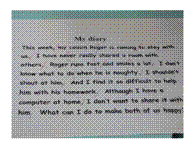
|
Word level : to learn phonics skills
If students learn phonics skills, they can develop the basic awareness of the basic sound patterns and phonics rules, and this will help build up their confidence in decoding new words. Then they are more likely to pause at meaningful units when reading aloud rather than pause at every word they find difficult. The teachers decided to adopt the following methods to teach phonics to the two P5 classes. As the students had been taught some initial phonics skills at their P3 level, the teachers arranged more intensive skills instruction and practice now.
Some lessons on phonics skills:
- Teach students how to read initial consonant cluster words (sc-, sk-, sl-, sm-, sn-, sp-, squ-, st-, str-, sw-)
- Teach students how to work out the pronunciation of difficult words:
- Select the target content of a phonics teaching syllabus
- Teach the set of blends and rimes through explicit instruction
- Activities: Play a swatting game on initial consonant clusters. Have guided practice to revise the letter sounds and worksheets for consolidation and independent learning
|
Stage 4: Evaluation (II) (Assessment for learning)
- Design a test to track student progress in phonics skills
Jan 2011
Assessment for learning: collect data about the impact of the actions implemented on student learning |
In addition to providing scaffolding activities to help students address the problems identified earlier, the teachers also collected data to gauge the effectiveness of these scaffolding activities and to inform successive action cycles. To track students’ learning progress, the teachers devised a phonics test to be used as both pre-test and post-test.
Focus: Rimes and blends
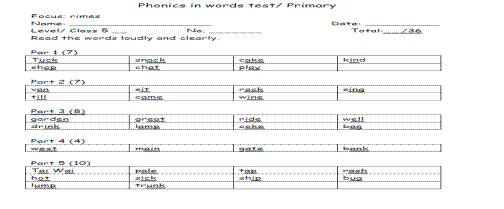
The pre-test is a test paper for students to read aloud individual words. Students had to read 36 words in the section on rimes and 35 words in the section on blends. Words are chosen from words in the textbooks or words they should know in daily life, e.g Tai Wai; and the words are grouped into categories based on their similarity in the letter pattern, e.g. sm, sn, sc, st, sk, sp.

A profile of students’ knowledge of phonics skills was obtained through the pre-test in term 1. Students were put into groups (i.e. poor, weak, average, good and very good) according to the marks they obtained in the pre-test in the section on blends and the section on rimes. This enabled the teachers to identify a group of weaker students that required special support, and also difficult areas common to most students.
In the pre-test, the overall trend of the performances of individual parts:

|
Teachers addressed the results of the pre-test by changing emphasis on the content of teaching:
For 5A, it is recommended that rimes be taught more intensively.
Rimes - Part 4, part 5
Blends - Part 5 |
For 5B, it is recommended that rimes be taught more intensively.
Sequence of teaching :
Rimes - Part 4, part 5
Blends - Part 2 |
|
Stage 5: Planning-Implementation (II)
- Plan and implement actions that take into account the findings and implications worked out : to provide scaffolding activities for student learning
Apr 2011- May 2011
Remediation and instruction |
The teachers planned a series of interesting games to encourage students to practise English word sounds.
Consolidation and self-learning
The teachers assigned further phonics skills exercises in class and produced a self study booklet for students to do more practice at home over the long holidays.
|
Stage 6: Evaluation (III)
Evaluate the effectiveness of the project with reference to the video recordings of student performance, test papers, questionnaires and other relevant written and oral work to measure student progress
| Jun 2011
End-of-Year Assessment
Overall evaluation |
In June, the students took the same test and the results of the post-test were compared with those in the pre-test. The analysis showed some progress had been made by different groups of students.
Evaluation:
The end-of-year evaluation questionnaire contains a new question on the teaching/learning activities:
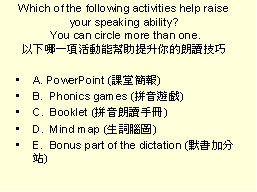
|
|

